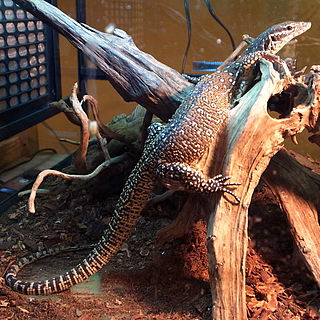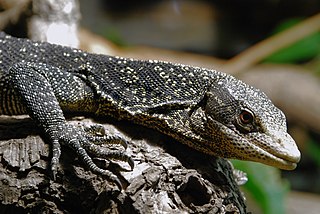
Monitor lizards are lizards in the genus Varanus, the only extant genus in the family Varanidae. They are native to Africa, Asia, and Oceania, and one species is also found in the Americas as an invasive species. About 80 species are recognized.

The mangrove monitor, mangrove goanna, or Western Pacific monitor lizard is a member of the monitor lizard family with a large distribution from northern Australia and New Guinea to the Moluccas and Solomon Islands. It grows to lengths of 3.5 to 4 ft.

The emerald tree monitor or green tree monitor, is a small to medium-sized arboreal monitor lizard. It is known for its unusual coloration, which consists of shades from green to turquoise, topped with dark, transversedorsal banding. This coloration helps camouflage it in its arboreal habitat. Its color also makes the emerald tree monitor highly prized in both the pet trade and zoos alike.

The peacock monitor, also known commonly as Auffenberg's monitor, is a species of small monitor lizard in the family Varanidae. The species, which belongs to the subgenus Odatria, is endemic to Rote Island, Indonesia.

The golden-spotted tree monitor, also known commonly as the golden speckled tree monitor, is a species of monitor lizard in the family Varanidae. The species is endemic to Waigeo Island in Indonesia.

The peach-throated monitor, also known commonly as the Sepik monitor, is a species of monitor lizard in the family Varanidae. The species is native to New Guinea.

The turquoise monitor is a species of monitor lizards found in Indonesia. Specifically, it is found on Halmahera Island and in the Maluku Islands.

The Ceram mangrove monitor is a species of monitor lizards found in Indonesia. Specifically, it is found on some of the central Moluccan Islands including: Ambon, Seram, Obi, Buru, and Banda. On Ambon and probably on New Guinea V. cerambonensis occurs sympatrically with Varanus indicus. It is in the indicus species group of the subgenus Euprepiosaurus.

The blue-tailed monitor, blue-tailed tree monitor or Kalabeck's monitor, is a monitor lizard of the Varanidae family. It belongs to the V. doreanus group of the subgenus Euprepiosaurus.
The sago monitor or torch monitor is a species of monitor lizards endemic to the Indonesian island of Sanana.
Varanus keithhornei, commonly known as the canopy goanna, Keith Horne's monitor, blue-nosed tree monitor, or Nesbit River monitor, is a species of monitor lizards native to northeast Australia. It is a member of the Varanus prasinus species group.
Finsch's monitor is a species of monitor lizard in the family Varanidae. The species is native to New Guinea and Australia.
The Rennell Island monitor is a species of monitor lizards found in the Solomon Islands archipelago. It is also known as the Hakoi Monitor. It belongs to the subgenus Euprepiosaurus along with the canopy goanna, the peach-throated monitor, Kalabeck's monitor, and others.
Varanus telenesetes, the mysterious tree monitor, is an enigmatic monitor lizard that may actually represent a colour faded specimen of the green tree monitor. The species was described based on a single specimen supposedly collected on Rossel Island in the Louisiade Archipelago of Papua New Guinea. However, later searches of this island have failed to turn up any specimens and native islanders deny ever seeing it. It is now believed that the original collection data was in error and that the species occurs on some other, currently unknown, island east of New Guinea.
Varanus rainerguentheri, also commonly known as Günther's mangrove monitor and Rainer Günther's monitor, is a species of lizard in the family Varanidae. The species is endemic to the Moluccas.

Varanus reisingeri, known commonly as Reisinger's tree monitor and the Yellow tree monitor, is a species of monitor lizard in the family Varanidae. The species is endemic to Indonesia. It was at one point at least considered an allopatric insular subspecies of the green tree monitor, due to physical and genetic similarities.
Bogert's monitor is a species of tree-dwelling lizard in the family Varanidae. The species is native to Papua New Guinea.

Bennett's long-tailed monitor is a species of monitor lizard in the family Varanidae. It is found in Palau, the Federated States of Micronesia, and the Northern Mariana Islands.

Hapturosaurus, sometimes known as the tree monitors, is a subgenus of lizards, consisting of slender-bodied arboreal monitor lizards mostly found in the tropical rainforests of Indonesia and Papua New Guinea.

Varanus tsukamotoi, the Mariana monitor or Saipan monitor, is a species of lizard of the Varanidae family. It is endemic to the Northern Mariana Islands and Guam, and has been introduced to Japtan in the Marshall Islands.














